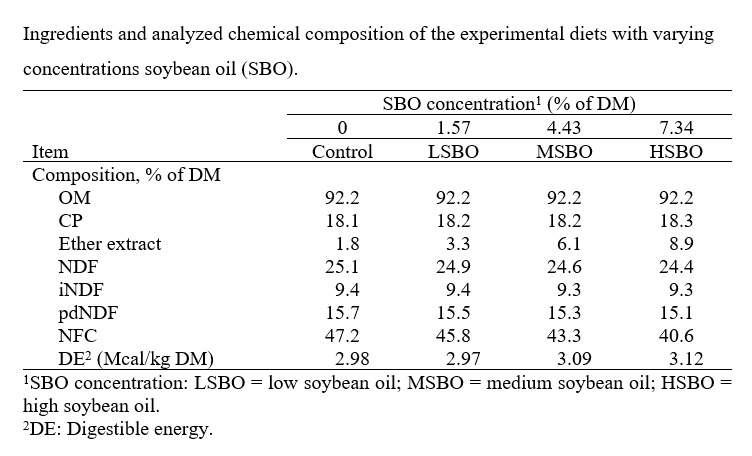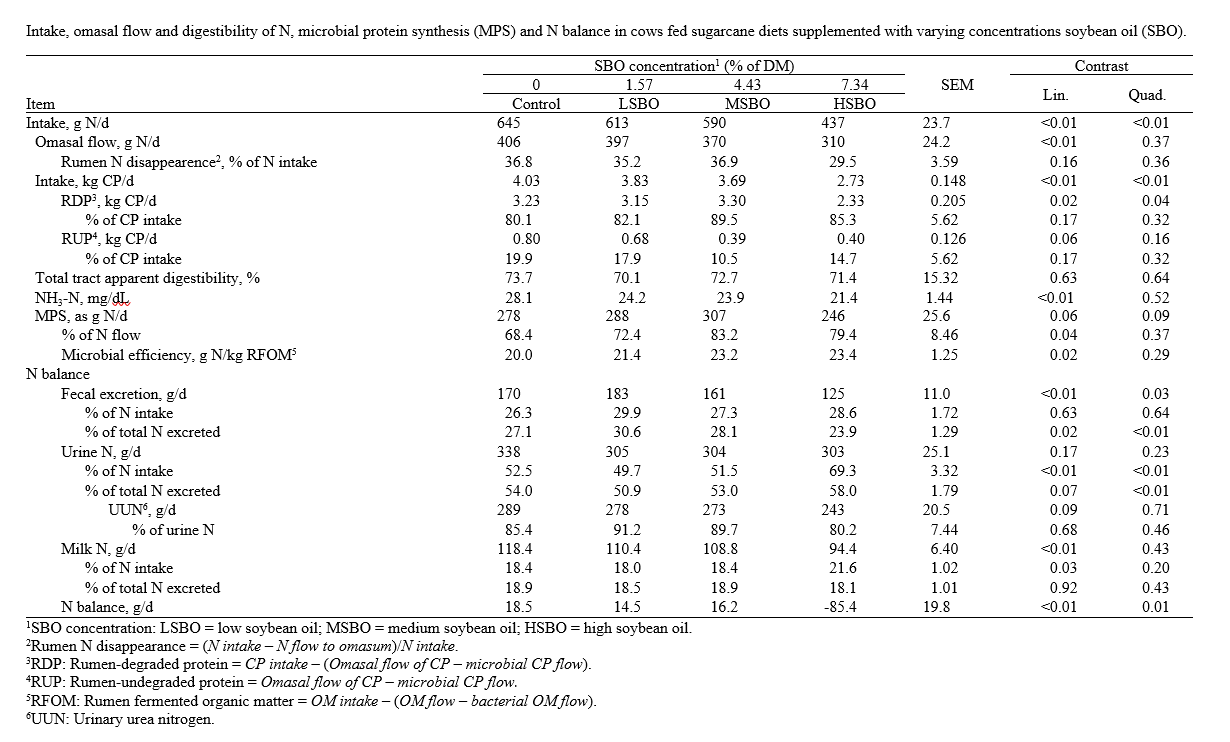
Balanço de nitrogênio em vacas alimentadas com cana de açúcar e níveis de óleo de soja
2 - Universidade Federal de Viçosa
3 - Universidade Federal de Viçosa
4 - Universidade Federal de Viçosa
5 - Universidade Federal de Viçosa
6 - Universidade Federal de Viçosa
7 - Universidade Federal de Viçosa
8 - Universidade Federal de Viçosa
RESUMO -
Objetivou-se quantificar as alterações na digestão de compostos nitrogenados em vacas leiteiras alimentadas com níveis de óleo de soja (SBO) em dietas com alto teor de concentrado e cana de açúcar. Oito vacas holandesas multíparas, fistuladas no rúmen, em média lactação (peso corporal = 574 ± 19,1 kg e 122 ± 6,9 dias em lactação), com média de 22,5 ± 1,22 kg / d de leite foram atribuídas a quadrados latinos 4 × 4 replicados. O período experimental foi de 21 dias: 14 dias para adaptação, seguido de um período de amostragem de 15 a 21 dias. As dietas foram formuladas com concentrações crescentes de SBO (% de matéria seca (MS)): controle (0%), baixa (LSBO, 1,57%), média (MSBO, 4,43%) e alta (HSBO, 7,34%). Alimentação com SBO a 7.43% da MS da dieta diminuiu muito o balanço de nitrogênio de vacas leiteiras e não deve ser usada.
Nitrogen balance in cows fed sugarcane based diets and increasing levels of soybean oil
ABSTRACT - We aimed to quantify the nitrogen digestion in dairy cows fed various concentrations of soybean oil (SBO) in high concentrate, sugarcane-based diets. Eight rumen-cannulated multiparous Holstein cows (body weight = 574 ± 19.1 kg and 122 ± 6.9 days in milk), averaging 22.5 ± 1.22 kg/d of milk were assigned to replicated 4 × 4 Latin squares. The experimental period lasted 21 d as follows: 14 d for adaptation, followed by a sampling period from d 15 to 21. The diets were formulated with increasing concentrations of SBO (% of dry matter (DM)): control (0%), low (LSBO; 1.57%), medium (MSBO; 4.43%) and high (HSBO; 7.34%). Feeding SBO at 7.43% of the diet DM greatly decreased nitrogen balance of dairy cows and should not be used.Introdução
Sugarcane is a forage frequently used as the main source of fiber for cattle in tropical environments. Due to its high indigestible fiber content, it is associated with a low intake of dry matter (DM) and, consequently, it needs more concentrate, leading to high levels of non-fibrous carbohydrates (NFC) in the diet. Supplementation with soybean oil (SBO) may be an alternative to increase energy intake and reduce NFC levels in the diet. However the use of vegetable oil can alter the intake and digestion of nutrients such as nitrogen. Our objective was to quantify the nitrogen digestion in dairy cows fed different levels of SBO in high concentrate diets with sugarcane as the main forage. By determining the response to increasing levels of SBO regarding nitrogen balance, we attempt to achieve a better understanding of the safe concentrations of SBO in sugarcane based diets.Revisão Bibliográfica
Sugarcane is a forage commonly fed to cattle in tropical environments and often used as the main dietary fiber source. It has excellent feeding potential for dairy cows because of its high productivity and wide harvesting window (Daniel et al., 2014). However, its use for high yielding dairy cows is usually associated with feeding high amounts of concentrates, leading to a high proportion of NFC in the diet (Oliveira et al., 2011). Furthermore, sugarcane fiber contains a high proportion of indigestible neutral detergent fiber (iNDF) and low potentially digestible neutral detergent fiber (pdNDF) at about 25 and 27% DM, respectively (Daniel et al., 2014) that is associated with a low DMI. Consequently, more concentrate is needed compared to corn silage-based diets (Oliveira et al., 2011). Under these feeding situations, fat supplementation can be an alternative to increasing energy intake while reducing dietary NFC concentration. However, the optimal inclusion rate of added fat, in diets with sugarcane as the sole forage, needs to be defined. The effects of fat supplementation on rumen metabolism in dairy cows has received considerable attention from the scientific community, considering the number of studies involving fat sources (Lerch et al., 2012) and interactions with forage and particle size (Piantoni et al., 2015). Despite the advances in knowledge of the effects of fat supplementation on rumen digestion, metabolism and changes in milk quality (Shingfield et al., 2008), little attention has been paid to the effects of different levels of the same fat source on nitrogen digestion using tropical forages.Materiais e Métodos
Eight, rumen-cannulated, multiparous, Holstein cows (574 ± 19.1 kg of BW and 122 ± 6.9 DIM) were used. The average milk production was 22.5 ± 1.22 kg/d at the beginning of the study. Cows were grouped in a replicated 4 × 4 Latin square design balanced for residual effects. The experimental period lasted 21 d, comprising of 14 d for adaptation followed by a sampling period from d 15 to 21. Four diets were formulated with increasing concentrations of SBO (%DM): control (0%), low (LSBO; 1.57%), medium (MSBO; 4.43%) and high (HSBO; 7.34%) (Table 1). The cows were milked twice daily at 05:50 and 14:50 h, and fed individually after each milking session. Intake was calculated by manually weighing the offered TMR and collected refusals. Diets were offered on an ad libitum basis and the amount offered was adjusted daily. Samples of sugarcane and diet refusals were taken from d 15 to 19 of each experimental period. Ruminal and total tract digestibility was estimated by collecting eight spot fecal and omasal digesta samples at 9 h intervals starting at 09:00 h on d 16. To estimate N balance urine samples (200 mL) were collected at the same times and kept frozen at -20°C. Samples were analyzed according to AOAC (2005). Microbial protein synthesis (MPS) was estimated according to Chen and Gomes (1992). The iNDF was used as an internal marker to estimate the fecal excretion of each nutrient. The omasal flow of nutrients was estimated using cobalt and iNDF as markers. The statistical analysis was performed using the SAS MIXED procedure (SAS Institute Inc., Cary, NC, version 9.4). The significance was declared at P < 0.05 and P-values from 0.05-0.10 were considered to indicate a trend.Resultados e Discussão
The experimental diets resulted in greater CP and RDP concentrations and rumen NH3-N than expected mainly due to the high CP in the diet (Table 1). The decrease in rumen NH3-N with SBO supplementation might be a consequence of the decrease in protozoal counts (Yang et al., 2009). The observed high rumen N-NH3 concentrations resulted in high MUN, BUN and UUN (Broderick et al., 2010). The high concentrations of NFC in the diets (Table 1) and high rumen NH3-N (Table 2) did not restrict microbial growth. However, the great adverse effects of the HSBO diet on N intake and rumen OM digestion resulted in a quadratic trend in MPS (P = 0.09). Thus, the linear increase in efficiency of MPS seems to be associated with the linear decrease in rumen fermented OM. Soybean oil supplementation quadratically decreased (P = 0.03) the fecal N excretion. The partition of excreted N quadratically decreased (P < 0.01) in feces and quadratically increased (P < 0.01) in urine as SBO increased. SBO supplementation quadratically affected (P = 0.01) the N balance, with the lowest value occurring in the HSBO diet. The negative N balance in the HSBO diet indicates that the N intake and metabolism of the cows were impaired by the extreme fat concentration. The N excretion in feces and urine, from the control until MSBO diet are similar to the observations by Hristov and Ropp (2003), evaluating high CP diets (19.5% DM) with high NFC. The authors demonstrated that ruminal digestible fiber can improve the transfer of ruminal NH3-N to N in milk. Considering the low pdNDF and high content of sucrose in fresh sugarcane, diets with this forage given to dairy cows should be formulated using other sources of pdNDF with relatively lower starch concentrations. However, data about the use of by-products with high pdNDF concentration in high concentrate sugarcane based diets are scarce in the literature (Lima et al., 2014).Conclusões
We concluded that SBO supplementation at 1.57% of the diet DM proved to be a safe concentration for dairy cows fed high concentrate diets with sugarcane as the sole forage. Feeding SBO at 7.43% of the diet DM greatly decreased nitrogen balance of dairy cows and should not be used. Due to the low pdNDF of sugarcane other feeding strategies such as supplementation with digestible fiber should be evaluated for dairy cows fed sugarcane based diets.Gráficos e Tabelas




